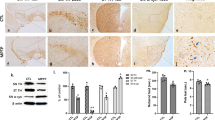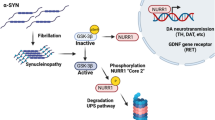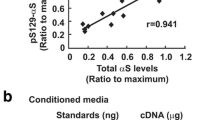Abstract
α-Synuclein (α-Syn) plays a crucial role in the pathophysiology of Parkinson’s disease (PD), the degeneration of dopaminergic neurons. Previous studies have shown that α-Syn regulates dopamine synthesis by binding to and inhibiting tyrosine hydroxylase (TH). In neurons, protein phosphatases (PPs) play a prominent role in directing signaling toward survival or degeneration. This study was to re-evaluate whether α-Syn could regulate the tyrosine hydroxylase phosphorylation by protein phosphatase-2A (PP2A) in dopaminergic MN9D cells and cortex neurons. Our data demonstrated for the first time that α-Syn stimulates PP2A activity and reduces phosphorylation of TH through regulating the methylation of PP2A in dopaminergic MN9D cells and primary cortex neurons. Increased PP2A activity and reduced phosphorylation of PP2A at Y307 (inactive form of PP2A) were observed in α-Syn overexpression dopaminergic cells (Syn) and primary cortex neurons, and the TH phosphorylation relieved by enhancing PP2A methylation in Syn group could be abated by using PP inhibitors, okadaic acid (OKA). OKA could reduce the cell damage and cell apoptosis induced by α-Syn. Thus our findings may provide an insight into the complicated pathogenesis of PD as well as some clues to the development of novel therapeutic strategies targeting at PP2A.





Similar content being viewed by others
References
Cegielska A, Shaffer S, Derua R, Goris J, Virshup DM (1994) Different oligomeric forms of protein phosphatase 2A activate and inhibit simian virus 40 DNA replication. Mol Cell Biol 7:4616–4623
Chen J, Martin BL, Brautigan DL (1992) Regulation of protein serine–threonine phosphatase type-2A by tyrosine phosphorylation. Science 257:1261–1264
Frasca D, Romero M, Landin AM, Diaz A, Riley RL, Blomberg BB (2010) Protein phosphatase 2A (PP2A) is increased in old murine B cells and mediates p38 MAPK/tristetraprolin dephosphorylation and E47 mRNA instability. Mech Ageing Dev 131:306–314
Geng X, Lou H, Wang J et al (2010) α-Synuclein binds the KATP channel at insulin secretory granules and inhibits insulin secretion. Am J Physiol Endocrinol Metab 300:E276–E286
Gentry MS, Hallberg RL (2002) Localization of Saccharomyces cerevisiae protein phosphatase 2A subunits throughout mitotic cell cycle. Mol Biol Cell 13(10):3477–3492
Gosavi N, Lee HJ, Lee JS, Patel S, Lee SJ (2002) Golgi fragmentation occurs in the cells with prefibrillar alpha-synuclein aggregates and precedes the formation of fibrillar inclusion. J Biol Chem 277:48984–48992
Lao DH, Yusoff P, Chandramouli S et al (2007) Direct binding of PP2A to Sprouty2 and phosphorylation changes are a prerequisite for ERK inhibition downstream of fibroblast growth factor receptor stimulation. J Biol Chem 282:9117–9126
Leal RB, Sim AT, Gonçalves CA, Dunkley PR (2002) Tyrosine hydroxylase dephosphorylation by protein phosphatase 2A in bovine adrenal chromaffin cells. Neurochem Res 27(3):207–213
Lechward K, Awotunde OS, Swiatek W, Muszyńska G (2001) Protein phosphatase 2A: variety of forms and diversity of functions. Acta Biochim Pol 48(4):921–933
Lee FJ, Liu F, Pristupa ZB, Niznik HB (2001) Direct binding and functional coupling of alpha-synuclein to the dopamine transporters accelerate dopamine-induced apoptosis. FASEB J 15:916–926
Lee HJ, Suk JE, Lee KW et al (2011) Transmission of synucleinopathies in the enteric nervous system of A53T alpha-synuclein transgenic mice. Exp Neurobiol 20(4):181–188
Lee J, Stock J (1993) Protein phosphatase 2A catalytic subunit is methyl-esterified at its carboxyl terminus by a novel methyltransferase. J Biol Chem 268(26):19192–19195
Letourneux C, Rocher G, Porteu F (2006) B56-containing PP2A dephosphorylate ERK and their activity is controlled by the early gene IEX-1 and ERK. EMBO J 25(4):727–738
Liu D, Jin L, Wang H et al (2008) Silencing α-synuclein gene expression enhances tyrosine hydroxylase activity in MN9D cells. Neurochem Res 33:1401–1409
Liu GP, Wei W, Zhou X et al (2012) I(2)(PP2A) regulates p53 and Akt correlatively and leads the neurons to abort apoptosis. Neurobiol Aging 33(2):254–264
Lou H, Montoya SE, Alerte TN et al (2010) Serine 129 phosphorylation reduces α-synuclein’s ability to regulate tyrosine hydroxylase and protein phosphatase 2A in vitro and in vivo. J Biol Chem 285(23):17648–17661
Longin S, Zwaenepoel K, Martens E et al (2008) Spatial control of protein phosphatase 2A (de)methylation. Exp Cell Res 314(1):68–81
Lu J, Kovach JS, Johnson F et al (2009) Inhibition of serine/threonine phosphatase PP2A enhances cancer chemotherapy by blocking DNA damage induced defense mechanisms. Proc Natl Acad Sci USA 106:11697–11702
Ogris E, Mudrak I, Mak E, Gibson D, Pallas DC (1999) Catalytically inactive protein phosphatase 2A can bind to polyomavirus middle tumor antigen and support complex formation with pp60(c-src). J Virol 73(9):7390–7398
Peng X, Tehranian R, Dietrich P, Stefanis L, Perez RG (2005) Alpha-synuclein activation of protein phosphatase 2A reduces tyrosine hydroxylase phosphorylation in dopaminergic cells. J Cell Sci 118:3523–3530
Perez RG, Hastings TG (2004) Could a loss of alpha-synuclein function put dopaminergic neurons at risk? J Neurochem 89:1318–1324
Perez RG, Waymire JC, Lin E, Liu JJ, Guo F, Zigmond MJ (2002) A role for alpha-synuclein in the regulation of dopamine biosynthesis. J Neurosci 22:3090–3099
Rochet JC, Outeiro TF, Conway KA et al (2004) Interactions among α-synuclein, dopamine, and biomembranes: some clues for understanding neurodegeneration in Parkinson’s disease. J Mol Neurosci 23:23–34
Ruvolo PP, Clark W, Mumby M, Gao F, May WS (2002) A functional role for the B56 alpha-subunit of protein phosphatase 2A in ceramide-mediated regulation of Bcl2 phosphorylation status and function. J Biol Chem 277(25):22847–22852
Saraf A, Oberg EA, Strack S (2010) Molecular determinants for PP2A substrate specificity: charged residues mediate dephosphorylation of tyrosine hydroxylase by the PP2A/B’ regulatory subunit. Biochemistry 49(5):986–995
Senior SL, Ninkina N, Deacon R et al (2008) Increased striatal dopamine release and hyperdopaminergic-like behaviour in mice lacking both alpha-synuclein and gamma-synuclein. Eur J Neurosci 27:947–957
Sidhu A, Wersinger C, Vernier P (2004) Does alpha-synuclein modulate dopaminergic synaptic content and tone at the synapse? FASEB J 18:637–647
Sim AT (1991) The regulation and function of protein phosphatases in the brain. Mol Neurobiol 5:229–246
Sontag E, Hladik C, Montgomery L et al (2004) Downregulation of protein phosphatase 2A carboxyl methylation and methyltransferase may contribute to Alzheimer disease pathogenesis. J Neuropathol Exp Neurol 63(10):1080–1091
Sontag E, Nunbhakdi-Craig V, Lee G et al (1999) Molecular interactions among protein phosphatase 2A, tau, and microtubules. Implications for the regulation of tau phosphorylation and the development of tauopathies. J Biol Chem 274(36):25490–25498
Sontag JM, Nunbhakdi-Craig V, Mitterhuber M, Ogris E, Sontag E (2010) Regulation of protein phosphatase 2A methylation by LCMT1 and PME-1 plays a critical role in differentiation of neuroblastoma cells. J Neurochem 115:1455–1465
Spillantini MG, Schmidt ML, Lee VM, Trojanowski JQ, Jakes R, Goedert M (1997) Alpha synuclein in Lewy bodies. Nature 388:839–840
Strack S, Westphal RS, Colbran RJ, Ebner FF, Wadzinski BE (1997) Protein serine/threonine phosphatase 1 and 2A associate with and dephosphorylate neurofilaments. Brain Res Mol Brain Res 49:15–28
Swingle M, Ni L, Honkanen RE (2007) Small-molecule inhibitors of ser/thr protein phosphatases: specificity, use and common forms of abuse. Methods Mol Biol 365:23–38
Tanimukai H, Grundke-Iqbal I, Iqbal K (2005) Up-regulation of inhibitors of protein phosphatase-2A in Alzheimer’s disease. Am J Pathol 166(6):1761–1771
Tehranian R, Montoya SE, Van Laar AD, Hastings TG, Perez RG (2006) Alpha-synuclein inhibits aromatic amino acid decarboxylase activity in dopaminergic cells. J Neurochem 99:1188–1196
Veeranna Yang DS, Lee JH et al (2011) Declining phosphatases underlie aging-related hyperphosphorylation of neurofilaments. Neurobiol Aging 32(11):2016–2029
Yasuda T, Miyachi S, Kitagawa R et al (2007) Neuronal specificity of alpha-synuclein toxicity and effect of Parkin co-expression in primates. Neuroscience 144:743–753
Yavich L, Tanila H, Vepsäläinen S, Jäkälä P (2004) Role of alpha-synuclein in presynaptic dopamine recruitment. J Neurosci 24:11165–11170
Youdim MB, Bakhle YS (2006) Monoamine oxidase: isoforms and inhibitors in Parkinson’s disease and depressive illness. Br J Pharmacol 147:S287–S296
Zhu Y, Duan C, Lü L et al (2011) α-Synuclein overexpression impairs mitochondrial function by associating with adenylate translocator. Int J Biochem Cell Biol 43(5):732–741
Acknowledgments
This work was supported by Grants from the National Basic Research Program of China (2011CB504103, 2012CB722407). The authors are Grateful for support from Key Laboratory for Neurodegenerative Disease of the Ministry of Education (2011SJBX03) and Beijing Center of Neural Regeneration and Repair, Beijing Key Laboratory of Brain Major Disorders (2011SJZS02).
Author information
Authors and Affiliations
Corresponding authors
Additional information
Gao Hua and Lan Xiaolei have contributed equally to this work.
Electronic supplementary material
Below is the link to the electronic supplementary material.
11064_2014_1477_MOESM1_ESM.tif
Supplementary 1 α-synuclein didn’t alter the protein level of AADC or MAO. A: The AADC protein level was measured by western blot. There was no statistical difference of AADC in Syn group or Sh-Syn group. B: Monoamine oxidase plays an essential role in the catabolism of neurotransmitter amines in central and peripheral tissues. There was no statistical difference of MAO (TIFF 511 kb)
Rights and permissions
About this article
Cite this article
Hua, G., Xiaolei, L., Weiwei, Y. et al. Protein Phosphatase 2A is Involved in the Tyrosine Hydroxylase Phosphorylation Regulated by α-Synuclein. Neurochem Res 40, 428–437 (2015). https://doi.org/10.1007/s11064-014-1477-x
Received:
Revised:
Accepted:
Published:
Issue Date:
DOI: https://doi.org/10.1007/s11064-014-1477-x




